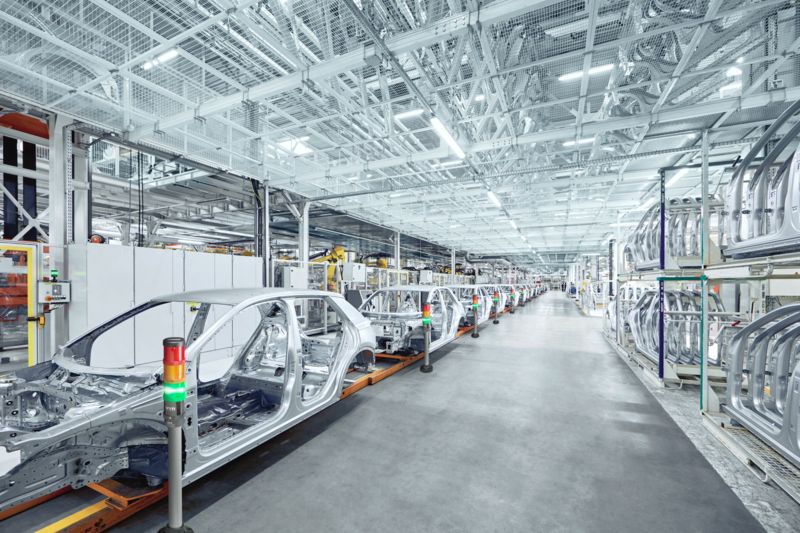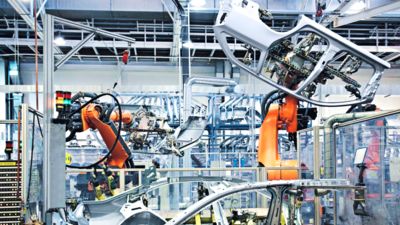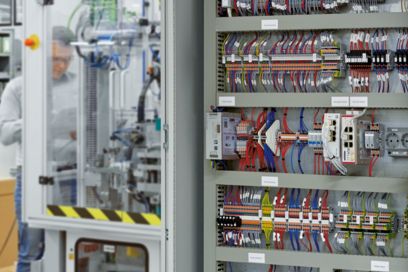What is predictive maintenance? Predictive maintenance is a method that uses Industry 4.0 technologies to monitor the condition of machines and predict potential failures.

Brief summary
Predictive maintenance, also known as preemptive maintenance, is an innovative maintenance strategy that aims to minimize downtime and extend the service life of machines in industry and machine building. The use of data analysis and predictive technologies makes maintenance more efficient and cost-effective.

Predictive maintenance reduces downtimes
Areas of application for predictive maintenance
The areas of application for predictive maintenance are diverse and far-reaching. They range from large industrial plants, through the automotive industry, right through to electronics production. Predictive maintenance brings decisive advantages wherever unplanned downtimes can result in high costs.

Predictive maintenance involves the constant monitoring of data
How does predictive maintenance work?
Predictive maintenance involves constantly monitoring machine statuses via installed sensors. In order to detect trends and anomalies, these sensors collect operational data, which is then analyzed. Machine learning models are used to predict when and which part of a machine is likely to fail.
Technical principles
The technical foundations of predictive maintenance include advanced sensor technology, cloud computing, and powerful data analysis processes. The data collected is processed in real time so that operators are informed immediately about the status of their systems, enabling them to take appropriate measures where necessary.

Predictive technologies ensure higher system availability
Real-world examples
Many industries, including manufacturing and machine building, have already started implementing predictive maintenance. One example is the automotive industry, where predictive maintenance has helped to optimize the maintenance intervals of production machines, significantly increasing both operational efficiency and production output. In the aviation industry, predictive technologies are helping to make aircraft safer by making maintenance work easier to plan and avoiding unexpected failures.
Advantages
- Reduced maintenance costs: Targeted maintenance based on actual data can avoid unnecessary maintenance work and high costs.
- Minimized unplanned downtimes: By identifying potential problems at an early stage, unplanned downtimes can be reduced significantly.
- Extended machine service life: Regular and needs-based maintenance increases the service life of machines.
- Increased efficiency and productivity: By avoiding downtimes, production operations remain uninterrupted, resulting in higher productivity.
Predictive and preventive maintenance
While preventive maintenance is based on regular, pre-planned maintenance work in which parts are replaced or checked regardless of whether there is any wear, predictive maintenance is geared toward taking action based on the actual condition of the machine. Interventions are only made if an analysis indicates that a failure is likely.

Maintenance strategies are planned based on data analysis
Prescriptive maintenance
Another advanced maintenance strategy is prescriptive maintenance, which not only predicts when maintenance should be carried out, but also makes specific recommendations for action. This type of maintenance also uses data analysis to find the optimum procedure for minimizing downtimes and costs.
Predictive maintenance vs. preventive maintenance
A comparison of these two approaches shows that predictive maintenance offers a data-supported, adaptive, and effective way of optimizing maintenance work. Preventive maintenance, on the other hand, is easier to implement but less flexible and less cost-efficient.
Steps for implementation
- Data acquisition: Installation of suitable sensors to monitor machine performance.
- Data analysis: Processing and analyzing the data collected to identified patterns and anomalies.
- Prediction: Application of machine learning models to predict potential failures.
- Maintenance plan creation and implementation: Planning and implementation of maintenance measures based on the analysis results.

Data is essential for predictive maintenance
Challenges during implementation
Even though the benefits of predictive maintenance are very attractive, companies often face challenges when trying to realize their maintenance strategy. A central issue is having access to high-quality data. If the data is not precise and comprehensive, predictive maintenance forecasts can be inaccurate. Furthermore, realizing a predictive maintenance strategy requires high start-up investments, both in technology and training, as well as changes to existing work processes.
The four maintenance strategies
There are four main maintenance strategies:
- Corrective maintenance: Reactive maintenance work that is carried out when a problem occurs.
- Preventive maintenance: Regular, time-controlled maintenance to prevent breakdowns.
- Predictive maintenance: Data-supported predictions for planning maintenance.
- Prescriptive maintenance: Extension of predictive maintenance with specific recommendations for action.
Summary
Predictive maintenance is a significant advance in maintenance strategy, helping companies to increase reliability through data analytics while improving efficiency through predictive maintenance. To meet the challenges of the future, the integration of technologies such as IoT, big data, and machine learning is making predictive maintenance a key part of the state-of-the-art Industry 4.0 landscape, providing industry, manufacturing, and machine building specialists with innovative tools.
Connect with our experts

More posts

Sensors make sheet metal forming more reliable
In automotive engineering, surface quality is the crowning discipline – with its sensor technology and digitalization, the retrofit system achieves greater process transparency, even in older press lines.

Coupling of factory and building
The Emalytics Automation building management system harmonizes data formats and intelligently networks sectors.

The All Electric Society – how sector coupling works
Flexibility with a battery storage system and energy management.



